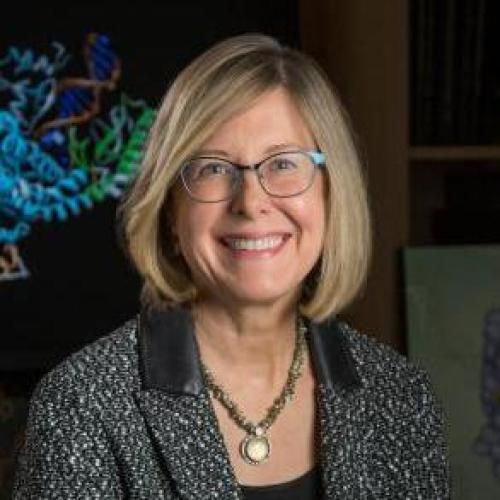Overview
Observing Enzymes in Action. A common theme in our research is the study of enzyme mechanisms at near-atomic resolution by determining three-dimensional structures that represent stages along the reaction pathway. Structural information is combined with biochemical, biophysical, and computational analyses to understand how enzymes function. This exciting direction originally arose from the observation that the DNA polymerase 1 we study retains catalytic activity in the crystal. This property enabled the study of the dynamic process of accurate DNA replication to be viewed and contrasted with replication under mutagenic conditions to understand molecular basis for mutations. Subsequently, we investigated enzymes essential for DNA repair. We were able to visualize the processive 5' to 3' DNA cleavage of human exonuclease I elucidating molecular mechanisms for a family of structure- specific nucleases. We are currently using time- lapsed X-ray crystallography to investigate the ATP- induced conformational changes of human MutS homologs. These observations may be critical for development of high specific allosteric inhibitors.
Protein Lipidation. Numerous signal transduction proteins, including members of the Ras GTPase superfamily, require posttranslational attachment of an isoprenoid lipid group for proper function. Our research has contributed to understanding the structural enzymology of the protein prenyltransferase family of lipid modifying enzymes. We have determined the first three-dimensional structures of human protein farnesyltransferase (FTase) and geranylgeranyltransferase I (GGTase-1), enzymes that are considered promising anticancer drug targets. Subsequently, we have determined a complete series of structures representing the major steps along the reaction coordinate of these enzymes. From these observations we deduced the structural determinants of substrate specificity and an unusual mechanism in which product release requires binding of substrate, analogous to classically processive enzymes. We published a series of papers with chemists from both academia and industry that define binding modes for human protein farnesyltransferase inhibitors (FTIs) and describe their mechanism of inhibition.
Structure-based Drug Design. We are applying structure guided strategies to develop inhibitors that target protein prenyltransferases and several DNA repair proteins. We collaborate with medicinal chemists on the structure-based development novel FTIs for the treatment of cancer and infectious diseases. Our laboratory determined the mechanism of action of peptidomemetic farnesyltransferase inhibitors (FTIs) that show tumor regression in animal studies and chemotherapreutics used in clinical trials for treatment of human cancer. Currently, the laboratory is using structural differences among protein prenyltransferases to develop inhibitors that specifically target human pathogens. Development of therapeutics to treat pathogenic fungi (Candida, Cryptococcus, Aspergillus) is an urgent need. Recently, our multi-disciplinary team used structure-guided strategies targeting fungal FTase to discover new, high affinity, potent anti-fungals. A new direction of the lab is the development of therapeutics for treatment of neurodegenerative diseases such as Huntington's Disease. We working to leverage our knowledge of human DNA repair proteins that are essential for DNA triplet repeat expansions (TRE) to identify new classes of inhibitors.
DNA Mismatch Repair. Our laboratory is investigating protein DNA assemblies involved in human mismatch repair using X-ray crystallography and cryoEM. Mismatch repair is essential for maintaining genomic stability of all organisms. Defects in genes involved in human mismatch repair lead to elevated mutation rates and confer a strong predisposition to tumorigenesis. Paradoxically, certain repair proteins are required for DNA triplet repeat expansions (TRE) that underly a number of neurodegenerative diseases. Currently, experiments are focused on developing a structural understanding of protein-DNA assemblies involved in the initiation of the human mismatch repair reaction.
We elucidated the structure of human exonuclease I with DNA substrates that led to an understanding of the mechanism of a family of DNA repair nucleases. Using time resolved X-ray crystallography we determined a unified mechanism for endo and exonuclease reactions. We determined the crystal structures of human MSH2-MSH6 (MutSα) and MSH2-MSH3 (MutSβ) DNA lesion recognition complexes, the primary sensors of replication errors. We elucidated nucleotide and substrate induced conformational rearrangements of these proteins that facilitate our understanding of cancer causing HNPCC mutations. We are applying our knowledge of these proteins to develop of allosteric inhibitors to probe mechanism of TREs and as potential therapeutics for treatment of neurodegenerative diseases.
DNA polymerases. By integrating high-resolution X-ray structures with functional studies and computational analyses we have been able to elucidate key features that determine high-fidelity DNA replication. This work exploited the properties of a DNA polymerase I that replicates DNA even when crystallized, allowing us to capture high-resolution snapshots of this polymerase in action. These approaches enabled us to (i) capture all mismatched bases bound in a polymerase active site and identified structural mechanisms that lead to polymerase stalling and subsequent error correction; (ii) establish the molecular basis for the mutagenicity of several classes of damaged DNA including O6-methyl-guanine lesions and 8-oxo guanine lesions; (iii) capture a tautomeric C-A mismatched base pair that is isosteric to a correct Watson-Crick base pair in the polymerase active site, providing the first direct evidence for the rare tautomer hypothesis for spontaneous mutagenesis noted by Watson and Crick in 1954.

